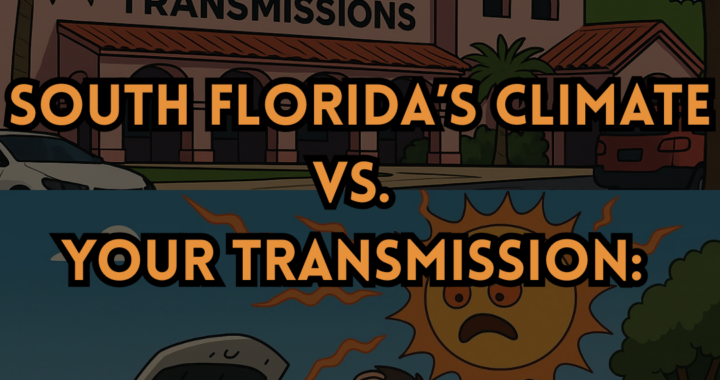South Florida is known for sunny skies and ocean breezes, but car owners know this paradise can be harsh on vehicles, especially their transmissions. If you have a high-mileage vehicle in this region, understanding how heat, traffic, and coastal humidity affect your transmission can save you from unexpected headaches and costly repairs. This guide will explore these challenges and offer straightforward advice for keeping your transmission in great shape.
Extreme Heat: Your Transmission’s Biggest Threat
While South Florida’s tropical climate is perfect for beach days, it spells trouble for your transmission. Automatic transmissions depend heavily on fluid for lubrication and cooling. Unfortunately, intense heat causes transmission fluid to break down more quickly, reducing its effectiveness. As fluid degrades, it loses its ability to lubricate parts, leading to increased friction, overheating, and eventual wear. The fluid may even darken and develop a burnt smell, clear signs it’s deteriorating.
With temperatures routinely soaring into the 90s, transmissions in South Florida constantly operate near their upper limits. Studies show transmission fluid can last 100,000 miles at 200°F but deteriorates to just 10,000 miles at 240°F. Metal components expand under heat, placing stress on bearings, clutches, and seals. Rubber seals and gaskets become brittle or warped, causing leaks and internal damage. In short, high-mileage vehicles in South Florida often experience accelerated wear due to persistent heat stress.
Stop-and-Go Traffic: The Daily Strain on Your Gears
South Florida’s infamous congestion, from I-95 to Miami’s downtown streets, places additional stress on transmissions. Frequent stopping and starting means constant shifting between gears, which significantly increases wear. Each gear shift generates internal heat, and the fluid rarely gets a chance to cool down adequately. In contrast, highway driving maintains steady gear usage, reducing heat buildup and internal strain.
If your daily commute involves heavy traffic, you’re essentially putting your transmission through rigorous “severe service” conditions. Over time, the heat from frequent shifts leads to faster clutch wear and shorter fluid lifespan, hastening potential transmission issues in high-mileage cars.
Humidity and Salty Air: Hidden Corrosion Culprits
Coastal living has its perks, but South Florida’s humid and salty air quietly attacks your car’s metal components. Rust isn’t just a winter issue; coastal corrosion is equally problematic, though often invisible until serious damage occurs. Transmission parts such as cases, fluid lines, and electrical connectors are particularly susceptible. Even the vehicle’s subframe can weaken from corrosion, creating safety concerns and costly repairs.
Salt and humidity combine to accelerate oxidation, penetrating protective coatings and slowly corroding metal beneath. Over time, transmission components and their seals degrade, causing leaks and unreliable performance. High-mileage coastal vehicles typically face these challenges much sooner than their inland counterparts.
Towing, Beach Driving, and Heavy Loads: Extra Transmission Stress
South Florida’s lifestyle frequently involves activities like towing boats, hauling cargo, or navigating soft beach sands, each dramatically increasing transmission strain. Towing adds significant weight and heat stress, while beach driving forces the transmission to work harder against loose terrain. Both scenarios increase fluid temperatures and wear.
Even highway driving can be demanding here, as prolonged exposure to high temperatures, like long trips on Alligator Alley, maintains transmission fluids at elevated temperatures, shortening their lifespan. Combined with salt spray and traffic, these factors often form a harsh trifecta that rapidly wears down transmissions.
Florida vs. Cooler Climates: A Tale of Transmission Longevity
Vehicles in cooler, less humid climates typically enjoy longer transmission lifespans because heat stress and corrosion are significantly reduced. Cooler climates help transmission fluid remain effective longer, while dry conditions prevent the corrosion seen in coastal areas.
Comparatively, a South Florida transmission undergoes constant thermal cycling and corrosive conditions, significantly reducing its service life. Thus, proactive care and maintenance are crucial here.
Tips to Protect Your Transmission in South Florida
Fortunately, there are practical steps you can take to extend your transmission’s life:
- Reduce Heavy Loads: Avoid overloading your vehicle or exceeding towing capacities. Consider an auxiliary transmission cooler for frequent towing.
- Regular Cleaning: Routinely wash your vehicle’s undercarriage after beach visits or exposure to saltwater to prevent corrosion.
- Fluid Checks: Regularly inspect transmission fluid for color and odor—healthy fluid is reddish without a burnt smell. Act quickly on any signs of deterioration.
- Cooling System Maintenance: Keep your engine’s cooling system well-maintained, as it directly impacts transmission fluid temperatures.
These simple, non-technical strategies significantly increase your transmission’s resilience in South Florida’s demanding conditions.
Expert Transmission Care in South Florida
Even the best-maintained vehicles can encounter transmission issues over time. Gold Coast Transmissions is your trusted partner for diagnosing and repairing transmissions in South Florida. With decades of local experience, our friendly team can quickly identify problems and provide reliable solutions.


